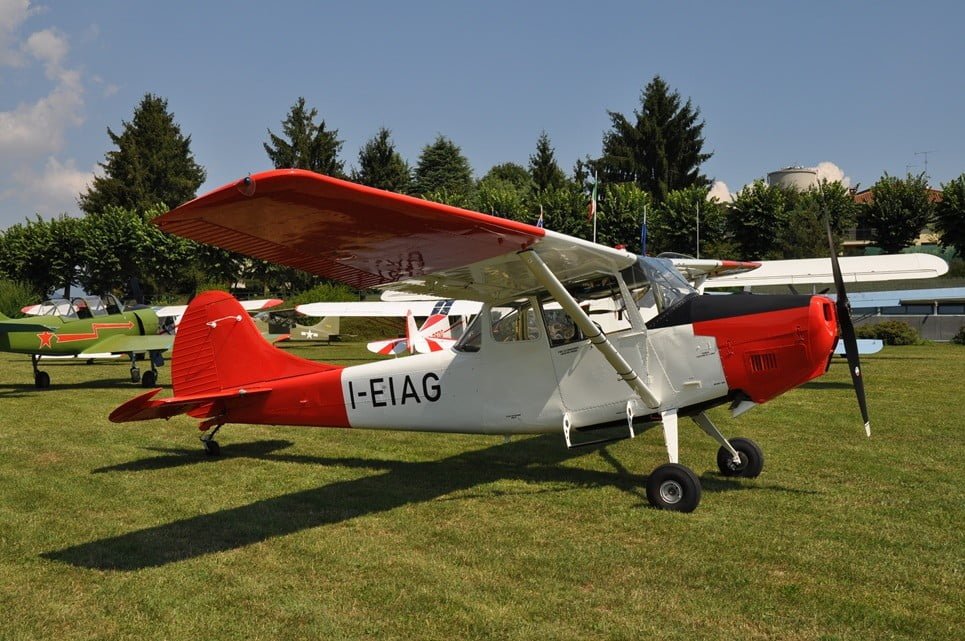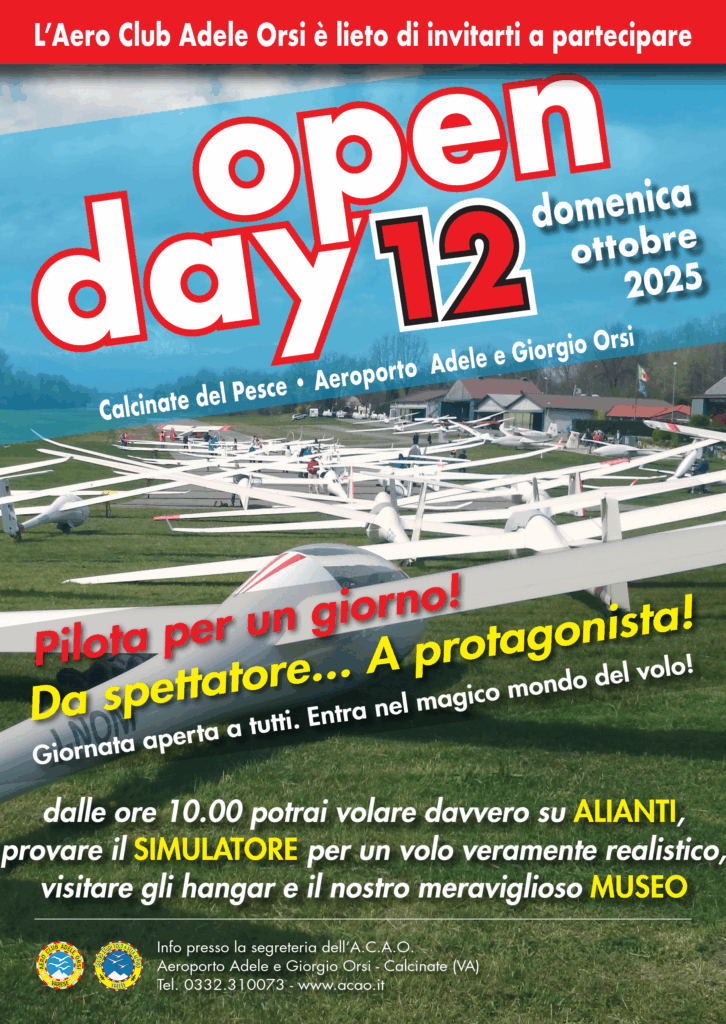
Cessna L19 I-EIAG
The Cessna L-19 Bird Dog, later redesignated O-1 Bird Dog, was a high-wing observation, reconnaissance and liaison aircraft produced by the U.S. Cessna Aircraft Company in the 1950s.
Derived from the Cessna 170 it was used mainly by the United States Air Force during the Vietnam War.
Development
The Bird Dog was born out of the United States Army’s need for a new light aircraft to provide guidance to artillery on marksmanship, as well as fill the role of a liaison aircraft, that would replace the role peers produced by Stinson and Piper. The latter, which were widely used during World War II, had a rather short operational life because of their construction technique, based on a mixed structure with a wooden wing and fuselage made of welded steel tubes, covered in cotton cloth. The U.S. Army issued a notice whose specifications covered a two-seat monoplane aircraft of all-metal construction in which Cessna Aircraft Company also participated by submitting its Cessna Model 305A developed from the Cessna 170.
The 305A was a lightweight single-engine high-wing counter-ventilated aircraft with conventional bicyclo undercarriage and a rear landing wheel. The major differences with the 170 were in the cabin equipped with two tandem seats, the only Cessna model ever to have this feature, and large windows to improve ground observation. In addition, the rear part of the fuselage was redesigned to provide a view directly to the rear, a solution later renamed “Omni-View” and applied to Cessna single-engine aircraft after 1964, and transparent panels were inserted in the middle section between the two wings, also used in the Cessna 140 and the later Cessna 150 Aerobat, and which allowed the pilot to have a view above his head as well. The access door to the cabin was also modified by enlarging it to allow the loading of a stretcher. The wing, on the other hand, was almost identical to that of the 170, with the exception of the greater flap travel (60 degrees instead of 40).
The U.S. Army entered into a contract with Cessna to supply 418 examples which were given the military designation L-19A Bird Dog. The prototype Cessna 305, registry number N41694, first flew on December 14, 1949 after which mass production was started with delivery of the first examples occurring from December 1950. The new aircraft was immediately used in wartime actions during the Korean War until 1953. In 1953 an instrument flight training version was developed, which was followed by a series of versions characterized by the variable pitch propeller(constant-speed propeller) and a final version, the L-19-E, characterized by an increased value of load capacity. The quantity of Bird Dog produced will amount to 3431 to which must be added those made by the Japanese company Fuji Heavy Industries under license.
The model received the name Bird Dog following a survey of Cessna employees and was chosen because of the similarity of the tasks it would have to perform in the field, namely to scout the enemy like a bloodhound, fly around them so as to allow artillery, or through an airstrike, to locate and engage them, then flying at low altitude check the damage inflicted and communicate by radio the need to further calibrate the shots or the success of the operation.
Operational history
L-19 of U.S. Marine Corps VMO-6 during the winter of 1951/52 in Korea
The U.S. Department of Defense entered into a supply contract for 3200 L-19 escaped from Cessna between 1950 and 1959. The aircraft was used in various operational roles including observation for artillery, for frontline communication, medevac and as a trainer. In 1962 the U.S. Army’s L-19 was redesignated O-1 (Observation) Bird Dog and used in the Vietnam War. During the 1960s Bird Dogs were used by the South Vietnamese Air Force (ARVN-Army Republic Vietnam/SVAF South Vietnamese Air Force), U.S. Army and clandestine crews (Ravens). In 1964, the United States Department of Defense (DOD) issued a memorandum addressed to the U.S. Army arranging for the replacement of its fixed-wing flying fleet, the O-1 Bird Dogs, with rotary-wing ones.
However, the U.S. Army was allowed to keep a few as artillery support until the new helicopters were delivered. All of the operators mentioned above, including the U.S. Army, continued to use Bird Dogs throughout the conflict, however, most of the aircraft were operated by the USAF from 1964 until the end of the war in 1975, in the latter year flown primarily by South Vietnamese personnel. During the Vietnam War, the aircraft were used for reconnaissance and forward air control (FAC). It was later and gradually replaced by the faster twin-engine USAF O-2 Skymaster, which was introduced into the conflict from the mid-1960s. The last Bird Dog serving in the U.S. Army was officially disbarred in 1974.
An O-1 U.S. Army with a LZ Baldy fuel tanker, near Hoi An, Republic of Vietnam, late 1967 or early 1968
There were 469 O-1 Bird Dogs lost for various reasons during the Vietnam War, 178 USAF, 7 USMC and 284 between U.S. Army, Vietnamese air forces and clandestine operators, three of them by enemy SAM positions.[1]
In the phase of replacing USAF O-1s in favor of O-2s many Bird Dogs were sold as surplus. In the 1970s and 1980s, Ector Aircraft overhauled a good number of them by placing them on the market as Ector Mountaineers, equipped with the original motorization, and as Lycoming O-540-A4B5 remotorized Ector Super Mountaineers.
A good number of O-1s were delivered to the Civil Air Patrol (CAP) and used in air search duties, many of which were damaged by ground loops and other accidents. The only remaining operational specimen was displayed in front of CAP headquarters on static display located at Maxwell Air Force Base.
Canada
In Canada, the Royal Canadian Air Cadets modified L-19s for use as tow planes, equipping them with the distinctive hook to carry Schweizer 2-33[2] gliders in the air as part of their free-flight training program. This particular version, used in the Atlantic, Pacific, and Eastern regions, featured the use of a Hoffman four-bladed composite propeller that was smaller in size than the original and a new exhaust manifold, modifications both aimed at noise reduction. The fuel system was also modified from the original model, placing the fuel valve selector closer to the pilot. In addition, as was customary for glider towing aircraft, two rear-view mirrors were mounted on the structure.
Italy
In Italy, the L-19 was used by the Italian Army. Some of the examples struck off from the Italian Army have been re-registered for civilian use (marks I-EIxx) and given to some aeroclubs where they are used for towing gliders.
Information taken from Wikipedia, The free encyclopedia.
Retrieved from http://it.wikipedia.org/wiki/Cessna_O-1_Bird_Dog
